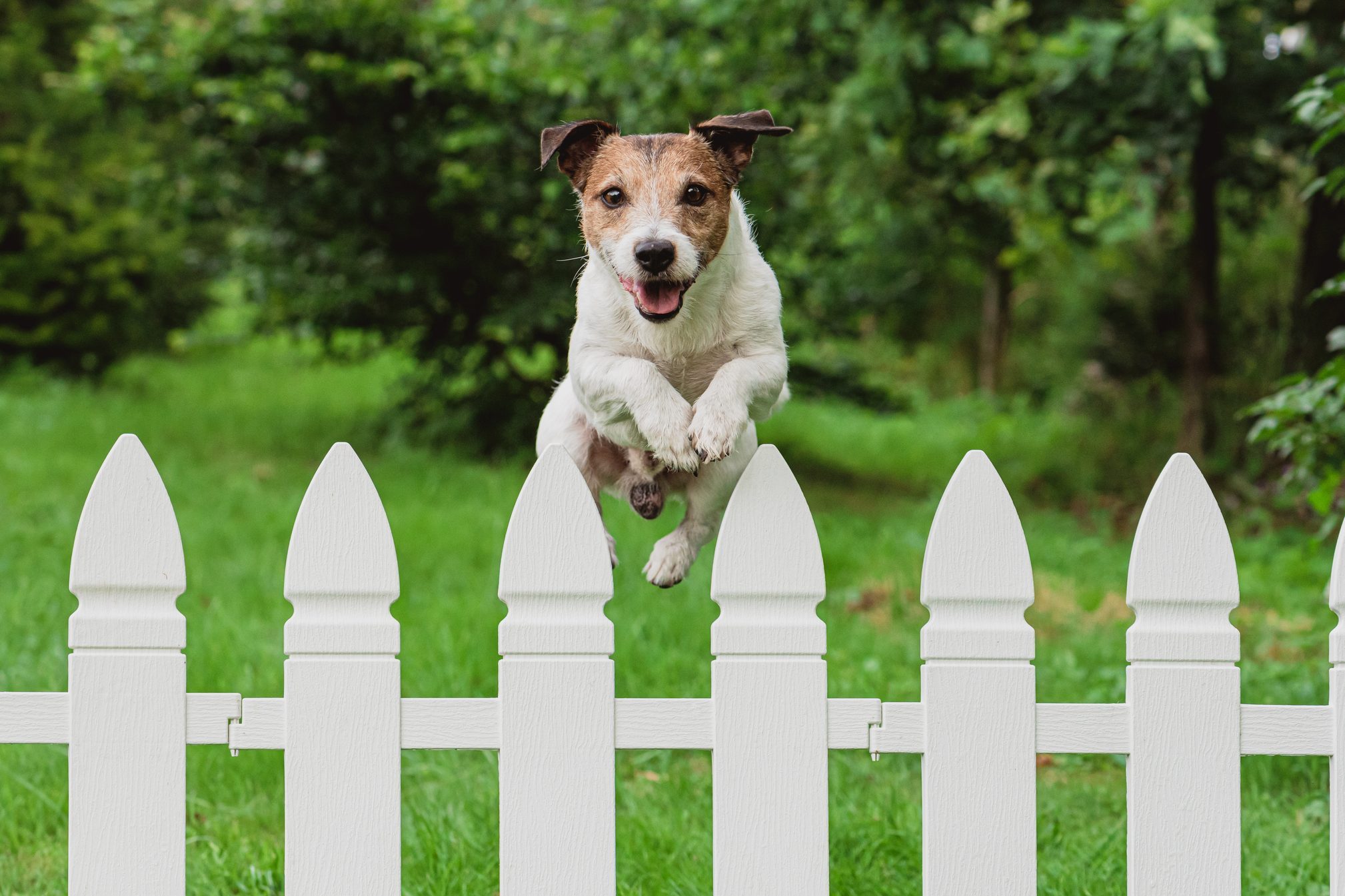Rather than banning your dog from the backyard, we've outlined expert-approved strategies to break their habit of jumping the fence.

How To Keep a Dog From Jumping the Fence

Your Houdini hound’s ability to sail over your backyard fence might be impressive, but these impromptu exits can lead to disastrous consequences.
According to certified professional dog trainer Lauren Wozniacki, “Dogs can get hit by a car, go after a person or another dog or simply become lost or injured.” And you’re liable for any injury or damage your dog causes when running amok.
To avoid those worries, we’ve compiled expert-approved strategies for keeping your dog from jumping the fence. We’ll also explain how to keep other dogs from jumping into your yard.
On This Page
Why Do Dogs Jump Fences?
Understanding why your dog wants to escape your yard determines how you tackle the problem. Wozniacki says her dog jumped the fence to chase wildlife.
Some common reasons for fence jumping include:
- Boredom;
- Separation anxiety;
- Sexual roaming;
- Prey drive;
- Territorial guarding;
- Social interactions;
- Other rewards, like a new place to play or different food;
- Fear.
Considering these motivations, here are seven strategies to keep dogs from jumping your fence.
Fence Adaptations
“I work with a Husky rescue, and Huskies are known for escaping the yard,” Wozniacki says. “The most success people have is making their yard escape-proof.”
Options include:
Install a taller fence or make your existing one higher
If you choose to install a new fence, make it at least six feet high for maximum security. A five-foot fence won’t contain large, athletic breeds, and even smaller dogs could scale it by scrambling up it. This is how Wozniacki solved her dog-escaping problem.
Try coyote rollers
If your pup or one from outside scales a high dog fence, fitting coyote rollers could stop the behavior. These bars prevent the dog from getting a pawhold to pull themself over the top. You can save money by making rollers from PVC pipe with wire or rope running through them.
Angled extension
If you’re not a fan of metal bars or plastic pipes, try adding fence extensions at a 45-degree angle, covered with chain-link fencing. Simple netting on the angled section can also be enough of a deterrent.
Solid fencing
For dogs who jump a fence whenever they see something through the slats or chain links, installing a privacy screen to block the view can work. Privacy screens may prevent other unwanted behaviors, like alert barking or territorial fence rushing.
Remodel Your Landscape
Even if you opt for a six-foot fence, your dog can still use elevated items as a launching pad. Make your landscaping dog friendly and move wood piles, climbing frames, trash cans, benches or rocks near the fence.
Planting thick evergreen shrubs like boxwoods in front of your fence also makes it trickier for your dog to hurdle it.
Supervise Yard Time
This often sets up your dog for success. They’re less likely to be bored and won’t try escaping to search for you. And you can speedily redirect them or bring them inside if they show interest in bold squirrels or barking dogs on the other side of the fence.
If they do make an escape, at least you can take immediate action, rather than learning hours later that your dog got out.
Offer Enrichment
Sometimes offering bored dogs more fun can be a simple fix for fence jumping. Wozniacki suggests increasing exercise. Trick training, she says, offers good mental simulation. In the yard, try keeping your dog busy with interactive treat toys like the Classic Kong. Build your furry friend a dog fence window.
Help Your Dog Feel Relaxed in the Yard
Loud noises in and around the yard can make your dog fearful of spending time out there. Maybe your dog tries to escape whenever the neighbor’s kids play exuberantly.
Watch your dog’s body language. If you see them cowering, trembling, lip licking, tail tucking or panting excessively when it isn’t hot, they may feel uncomfortable.
Wozniacki recommends keeping your dog indoors if the stress triggers happen at certain times of the day. For extreme anxiety or sound sensitivity, working with a certified behaviorist can help your dog feel more relaxed.
Consider Neutering Your Dog
Does your male dog always jump the fence to visit a favorite four-legged lady friend? “Neutering male dogs can absolutely help with roaming and escaping the yard,” Wozniacki says. But be aware: Once you allow your dog to establish a pattern, it becomes a learned behavior that neutering may not deter.
Provide Training
Training can reduce your dog’s desire to escape. Work on rewarding your dog when they don’t react to their triggers, and teach them to reliably come back to you when you call no matter what distracts them.
What Not to Do to Keep a Dog From Jumping the Fence
The methods above are dog-friendly. Others are not so friendly.
Invisible electric fences are common. However, studies show dogs are much more likely to escape yards with invisible fencing than appropriate physical fencing.
Wozniacki doesn’t recommend yelling or using devices that scare dogs, like electric collars or fences. Punishment and aversive tools can break down the bond you build with your dog, and increase the likelihood of problems with anxiety and aggression. And by the time you find your wayward dog, they won’t associate your yelling with their fence jumping anyway.




















